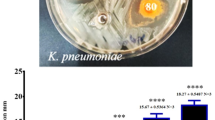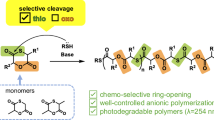Abstract
Dilithium diamides derived from silyl-protected diamines (that is, N,N′-bis(trimethylsilyl)-1,3-bis(aminomethyl)benzene and N,N′-bis(triisopropylsilyl)-1,3-bis(aminomethyl)benzene, 1a and 1b, respectively) were examined as difunctional initiators for the anionic polymerization of methyl methacrylate (MMA) in toluene with the aid of organoaluminum mediators. While the dilithium diamides in combination with tributylaluminum afforded the polymers in quantitative yields, the less sterically demanding silyl amide (1a) underwent 1,2-addition (carbonyl addition) during the initial stage of polymerization to form poly(MMA) (PMMA) containing the initiator fragment, with the methacryloyl group at the chain end as a minor component (26%). Dilithium diamide 1b, which contains triisopropylsilyl groups that prevent the 1,2-addition due to their steric bulkiness, afforded PMMA with a 1,3-xylylenediamine unit (initiation fragment) in the middle of the chain. H2/Pd-C-mediated cleavage of the diamine unit yielded PMMA with a half molar mass in a narrow molar-mass distribution, which provided proof of the equivalent reactivity of the two amide anions in 1b.
Similar content being viewed by others
Log in or create a free account to read this content
Gain free access to this article, as well as selected content from this journal and more on nature.com
or
References
Hsieh, H. L. & Quirk, R. P. Anionic Polymerization, Principles and Practical Applications, (Marcel Dekker, New York, NY, USA, 1996).
Szwarc, M. & Levy, M. Polymerization initiated by electron transfer to monomer. A new method of formation of block polymers. J. Am. Chem. Soc. 78, 2656 (1956).
Yu, Y. S., Dubois, Ph., Jérôme, R. & Teyssié, Ph. Difunctional initiators based on 1,3-diisopropenylbenzene. 3. Synthesis of a pure dilithium adduct and its use as difunctional anionic polymerization initiator. Macromolecules 29, 2738 (1996).
Kitayama, T., Ogawa, M. & Kawauchi, T. Monomer-selective living copolymerization of butyl acrylate and methyl methacrylate with a difunctional initiator—a facile synthesis of ABA-type triblock copolymer. Polymer (Guildf) 44, 5201 (2003).
Kitaura, T. & Kitayama, T. Anionic polymerization of (meth)acrylates with trialkylsilyl-protected lithium N-benzylamide. Polym. J. 40, 37 (2008).
Armstrong, D. R., Baker, D. R., Craig, F. J., Mulvey, R. E., Clegg, W. & Horsburgh, L. Benzyl(trimethylsilyl)amidolithium: structural studies by ab initio mo and X-ray crystallographic methods, and comparison with the known structures of dibenzyl and bis(trimethylsilyl) analogues. Polyhedron 20, 3533 (1996).
Okamoto, Y. & Yuki, H. Anionic polymerization of N-methacryloylaziridine. J. Polym. Sci. Polym. Chem. Ed. 19, 2647 (1981).
Suzuki, T., Kusakabe, J., Kitazawa, K., Nakagawa, T., Kawauchi, S. & Ishizone, T. Living anionic polymerization of N-methacryloylazetidine: anionic polymerizability of N,N-dialkylmethacrylamides. Macromolecules 43, 107 (2010).
Kitaura, T. & Kitayama, T. Anionic polymerization of methyl methacrylate with the aid of lithium trimethylsilanolate (Me3SiOLi)—superior control of isotacticity and molecular weight. Macromol. Rapid Commun. 28, 1889 (2007).
Kitayama, T., Shinozaki, T., Masuda, E., Yamamoto, M. & Hatada, K. Highly syndiotactic poly(methyl methacrylate) with narrow molecular weight distribution formed by tert-butyllithium-trialkylaluminum in toluene. Polym. Bull. 20, 505 (1988).
Kitayama, T., Zhang, Y. & Hatada, K. Preparetion of highly heterotactic polymethacrylate with narrow molecular weight distribution by t-butyllithium/bis(2,6-di-t-butylphenoxy)methylaluminum in toluene. Polym. J. 26, 868 (1994).
Author information
Authors and Affiliations
Corresponding author
Rights and permissions
About this article
Cite this article
Kitaura, T., Kitayama, T. Anionic polymerization of methyl methacrylate by difunctional lithium amide initiators with trialkylsilyl protection. Polym J 45, 1013–1018 (2013). https://doi.org/10.1038/pj.2013.29
Received:
Revised:
Accepted:
Published:
Issue date:
DOI: https://doi.org/10.1038/pj.2013.29
Keywords
This article is cited by
-
Comb-shaped Poly(eicosyl methacrylate) Polymer via reverse ATRP using Fe(III) complex
Journal of Polymer Research (2023)



